
JOURNAL PUBLICATIONS (* students/postdocs)
In press/ review/ revision
- Merheb*, C. Ravi, S. et al., Urban agrivoltaics enhance crop resilience and food-energy synergies in a changing climate
- Ravi et al., Internal feedback mechanisms driving shrub-grass dominance: from shrub encroachment to exotic grass invasions in North American deserts.
- Merheb*, C. Ravi, S, et al., Exploring micro-environmental conditions of urban agrivoltaics: advancing sustainable green spaces, rooftops, and agriculture in temperate cities
- Ravi et al., Thinking beyond carbon: Holistic improvement of soil-related ecosystem services from solar grazing systems
- Raabe*., M. Biochar mitigates the negative impact of compaction on the hydraulic performance of engineered soil media, in review
Published
-
- Merheb*. C. , J. Macknick, N. Davatzes and S. Ravi, (2025) Synergies and tradeoffs of multi-use solar landscapes, Nature Sustainability, https://doi. org/10.1029/2023JD039576 Featured on the cover (as cover image of August issue), Media coverage
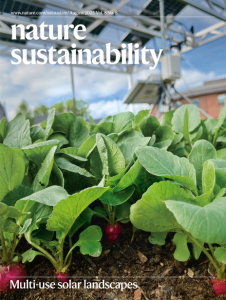
- Khatei*, K., T. Rinaldo, R. S. Van Pelt, P. D’Odorico and S. Ravi (2025), On the differential effects of salinity and sodicity on the aeolian erosion dynamics and particulate matter emissions, Earth Surface Processes and Landforms, 50(4), https://doi. org/10.1029/2023JD039576
- Choi*. C. S. , J. Macknick, J. McCall, R. Bertel* and S. Ravi, (2024) Multi-year analysis of interactions between solar pv arrays and underlying soil-vegetation systems at utility scale systems, Applied Energy, https://doi.org/10.1016/j.apenergy.2024.123227
- Khatei*, K., T. Rinaldo, R. S. Van Pelt, P. D’Odorico and S. Ravi (2024), Wind erodibility and particulate matter emissions of salt-affected soils: The case of dry soils in a low humidity atmosphere, Journal of Geophysical Research: Atmospheres, https://doi. org/10.1029/2023JD039576
- Leonard, J., S. Ravi and S. K. Mohanty, (2024) Preferential Emission of Microplastics from Biosolid-Applied Agricultural Soils: Field Evidence and Theoretical Framework, Environmental Science & Technology Lett. https://doi.org/10.1021/acs.estlett.3c00850
*Media Coverage: Los Angeles Times (Front page article), American Chemical Society (ACS Press Room), PÚLICO, Scienmag, WPN, MSN, EcoWatch, ScienceDaily, AAAS EurekaAlert, Science News Explores, Phys.Org
- Burger*, W. J., R. S. Van Pelt, D. E. Grandstaff, G. Wang, T. T. Sankey, J. Li, J. Sankey and S. Ravi (2023). Multi-year tracing of spatial and temporal dynamics of post-fire aeolian sediment transport using rare Earth elements provide insights into grassland management. Journal of Geophysical Research: Earth Surface, 128, e2023JF007274. https://doi. org/10.1029/2023JF007274
* Highlighted by the American Geophysical Union AGU-EoS. Editors highlights: by Okin et al. (2024) Rare earth element tracers provide insight into how fire and sediment transport influence the vegetation state of the world’s drylands.
- Choi*. C. S., J. Macknick, Y. Li, D. Bloom*, J. McCall and S. Ravi (2023), Environmental Co‐Benefits of Maintaining Native Vegetation With Solar Photovoltaic Infrastructure, Earth’s Future, 11(6), https://doi.org/10.1029/2023EF003542 , Featured on the cover (as cover image of Earth’s Future), Top viewed/downloaded article 2023-2025)
- Merheb*. C. , J. Macknick, N. Davatzes and S. Ravi, (2025) Synergies and tradeoffs of multi-use solar landscapes, Nature Sustainability, https://doi. org/10.1029/2023JD039576 Featured on the cover (as cover image of August issue), Media coverage
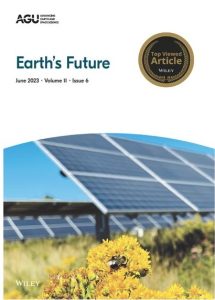
-
-
- Das, T. K., H. Le., M. K. Stenstorm, S. Ravi, and S. K. Mohanty (2023), The Amount of Sand Required to Transform Roadside Compacted Soil into Sustainable Stormwater Treatment Solutions, Journal of Sustainable Water in the Built Environment, 9(4), https://doi.org/10.1061/JSWBAY.SWENG-510
- Koutnik, V.S., A. Borthakur, J. Leonard, J. Brar, S. Cao, J. Glasman, W. Cowger, S. Ravi, and S. K. Mohanty (2022), Transport of microplastics in stormwater treatment systems under freeze-thaw cycles: Critical role of plastic density, Water Research, 222, 118950. https://doi.org/10.1016/j.watres.2022.118950
- Ravi, S., Law, D. J., Caplan, J. S., Barron-Gafford, G. A., Dontsova, K. M., Espeleta, J. F., Villegas, J. C., Okin, G. S., Breshears, D. D., & Huxman, T. E. (2022). Biological invasions and climate change amplify each other’s effects on dryland degradation. Global Change Biology, 00, 1–11. https://doi.org/10.1111/gcb.15919
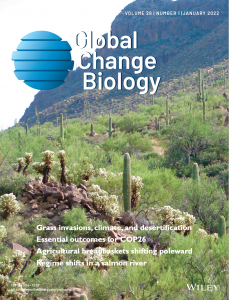
*Featured on the cover (as cover image of Global Change Biology)
*AGU Eos: Earth and Space Science News, Research spotlight by Kornei, K. (2022), Invasive Plants and Climate Change Will Alter Desert Landscapes, Eos, 103, https://doi.org/10.1029/2022EO220027.
-
- Li J., S. Ravi, G. Wang,. J. Sankey, T. E. Gill, and S. Van Pelt (2022), Woody plant encroachment of grassland and the reversibility of shrub dominance: Erosion, fire, and feedback processes, Ecosphere. 13(3) e3949 https://doi.org/10.1002/ecs2.3949
- Koutnik, V.S., Leonard, J., Glasman, J.B., Koydemir, H.C., Novoselov, A., Brar, J., Bertel*, R., Tseng, D., Ozcan, A., Ravi, S., Mohanty, S.K. (2022) Microplastics retained in stormwater control measures: Where do they come from and where do they go? Water Research. 118008. https://doi.org/10.1016/j.watres.2021.118008
- Koutnik, V.S., A. Borthakur, J. Leonard, S. Alkidim, J.B., Koydemir, H.C., A. Novoselov, D. Tseng, A. Ozcan, S. Ravi, and S. K. Mohanty (2022) Mobility of polypropylene microplastics in stormwater biofilters under freeze-thaw cycles, Journal of Hazardous Materials Letters. 3, 100048 [Editor’s Choice] https://doi.org/10.1016/j.hazl.2022.100048.
- Choi*. C., S. Ravi, I. Z. Siregar, F. G. Dwiyanti, J. Macknick, M. Elchinger, and N. C. Davatzes (2021), Combined land use of solar infrastructure and agriculture for socioeconomic and environmental co-benefits in the tropics, Renewable and Sustainable Energy Reviews, 151, 111610, https://doi.org/10.1016/j.rser.2021.111610
- Sankey, J. B., T. T. Sankey, J. Li., S. Ravi, G. Wang, J. Caster and A. Kasprak (2021),Quantifying plant-soil-nutrient dynamics in rangelands: Fusion of UAV hyperspectral-LiDAR, UAV multispectral-photogrammetry, and ground-based LiDAR-digital photography in a shrub-encroached desert grassland, Remote Sensing of Environment, 253, 112223, https://doi.org/10.1016/j.rse.2020.112223
- Koutnik, V. S., J. Leonard, S. Alkidim, F. J. DePrima, S. Ravi, E. M. V. Hoek and S. K. Mohanty (2021), Distribution of microplastics in soil and freshwater environments: Global analysis and framework for transport modeling, Environmental Pollution, 274, 116552, https://doi.org/10.1016/j.envpol.2021.116552
- Borthakur, A., J. Leonard, V. Koutnik, S. Ravi, and S. K. Mohanty (2021) Inhalation risks from wind-blown dust in biosolid-applied agricultural lands: Are they enriched with microplastics and PFAS, Current Opinion in Environmental Science & Health, 25, 100309 https://doi.org/10.1016/j.coesh.2021.100309
- Alam, S., A. Borthakur, S. Ravi, M. Gebremichael, and S. K. Mohanty (2021), Managed aquifer recharge implementation criteria to achieve water sustainability, Science of The Total Environment, 768, 10, https://doi.org/10.1016/j.scitotenv.2021.144992
- Wang G*, J. Li, S. Ravi, B. Theiling and W. Burger* (2021), Fire-induced microsite-scale spatial heterogeneity of soil nitrogen (N) and δ15N: Implications for N cycling at a grassland-shrubland ecotone, Journal of Arid Environments, https://doi.org/10.1016/j.jaridenv.2020.104422
- Ravi S., J. Li, Z. Meng, J. Zhang, and S. Mohanty (2020), Generation, resuspension, and transport of particulate matter from biochar‐amended soils: A potential health risk, GeoHealth, https://doi.org/10.1029/2020GH000311
- Choi*, C., A. Cagle*, D. Bloom*, J. Macknick and S. Ravi (2020), Effects of revegetation on soil physical and chemical properties in solar photovoltaic infrastructure, Frontiers in Environmental Science, 10.3389/fenvs.2020.00140. *Frontiers in Environmental Science – Editor’s Picks 2021, selected among the most well-received stand-alone articles from 2019 to early 2021
- Ghavanloughajar, M., H. Le, Md. M. Rahman, R. Valenca, A. Borthakur, S. Ravi, and S. Mohanty (2020), Compaction alters biochar performance in stormwater biofilter. Science of the Total Environment, 735: 139180, http://doi.org/10.1016/j.scitotenv.2020.139180
- Le H. , R. Valenca, S. Ravi, M. Stenstorm and S. Mohanty (2020), Biochar size determines the compaction-induced biochar breaking mechanism in roadside biofilters, Environmental Pollution, https://doi.org/10.1016/j.envpol.2020.115195
- Stewart, J., K. M. Shakya, T. Bilinski, J. Wilson, S. Ravi and C. Choi* (2020), PM2.5 Variation of Near Surface Atmosphere Microbial Communities at an Urban and a Suburban Site in Philadelphia, PA, USA, Science of the Total Environment, 724: 138353, http://doi.org/10.1016/j.scitotenv.2020.138353.
- Berger, A., R. Valenca, Y. Miao, S. Ravi , S. Mahendra, and S. Mohanty (2019), Nitrate removal in biochar-augmented woodchip biofilters: Effect of rainfall extremes, Water Research, 165 , 115008, doi.org/10.1016/j.watres.2019.115008.
- Wang, L., K. F. Kaseke, S. Ravi, W. Jiao, R. Mushi, T. Shuuya and G. Maggs-Kölling (2019), Convergent vegetation fog and dew water use in the Namib Desert, Ecohydrology, doi.org/10.1002/eco.2130.
- Wang* G, J. Li , and S. Ravi (2019), A combined grazing and fire management may reverse woody shrub encroachment in desert grasslands, Landscape Ecology, doi.org/10.1007/s10980-019-00873-0.
- Wang*. G., J. Li, S. Ravi, B. Theiling, and J. Sankey (2019), Fire changes the spatial distribution and sources of soil organic carbon in a grassland-shrubland transition zone, Plant & Soil, 435(1-2), 309-321, doi.org/10.1007/s11104-018-3895-z.
- Ravi. S., H. Gonzales*, I. Buynevich, J. Li, J. Sankey, D. Dukes* and G. Wang (2019), On the development of a magnetic susceptibility-based tracer for sediment transport research, Earth Surface Processes & Landforms, doi.org/10.1002/esp.4536
- Gonzales*, H., S. Ravi, J, Li and J. Sankey (2018), Ecohydrological implications of sediment trapping by sparse vegetation in drylands, Ecohydrology, doi.org/10.1002/eco.1986. [Wiley, IF: 2.75]
- Dukes*, D., H. Gonzales*, S. Ravi, D. Grandstaff, J. Li, J. Sankey, G. Wang*, and S. Van Pelt (2018), Quantifying post-fire aeolian sediment transport using rare earth element tracers, J. Geophys. Res. Biogeosciences, doi:10.1002/2017JG004284.
- Li, J., and S. Ravi (2018), Interactions among hydrological-aeolian processes and vegetation determine grain-size distribution of sediments in a semi-arid coppice dune (nebkha) system, J. Arid Environments, 154, 24-33.
- Wang*., G., J. Li, S. Ravi, D. Dukes*, H. Gonzales*, and J. Sankey (2018), Post-fire redistribution of soil carbon and nitrogen at a grassland-shrubland ecotone, Ecosystems, doi.org/10.1007/s10021-018-0260-2.
- Trifunovic*, B., Gonzales*, H., S. Ravi, and B. Sharratt (2018), Dynamic effects of biochar concentration and particle size on hydraulic properties of biochar – amended sand, Land Degradation & Development, doi.org/10.1002/ldr.2906.
- Kumar, G., S. Ravi, S. Micallef, E. Brown, and D. Macarisin (2018), Aeolian contamination of fruits by enteric pathogens: An unexplored paradigm, Curr. Opin. Food Sci., doi:10.1016/j.cofs.2017.12.003. .
- Ravi, S., L. Wang, K. Kaseke, and I. Buynevich, Ecohydrological interactions within “fairy circles” in the Namib Desert: Revisiting the self-organization hypothesis, J. Geophys. Res. Biogeosciences , 122, doi:10.1002/2016JG003604.* Featured in the cover (as cover image of JGR) and most downloaded/cited paper of the year (2017-2018).
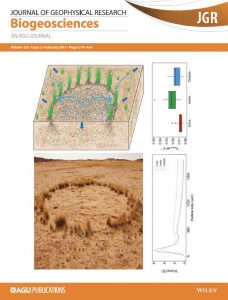
*Media Coverage: USA TODAY, PHYS.ORG, Science Daily, EOS.ORG (AGU), IndyStar, Science News Online, Daily Mail, WorldNews (WN), ScienceTimes, Temple University News, University Herald
*Research spotlight in EOS, Witman, S. (2017), Mysterious “fairy circles” continue to enchant scientists, Eos, 98, https://doi.org/10.1029/2017EO071017.
*Commentary by AGU Editor , (2017), The magic of fairy circles: Built or created?, J. Geophys. Res. Biogeosci., 122, 1294–1295, doi:10.1002/2017JG003855.
-
- Wang*, G., J. Li , S. Ravi, S. van Pelt , D. Dukes*, and P. J. Costa, Tracers techniques in aeolian research: Applications, challenges, and prospects, Earth Science Reviews, 170, 1-16. (Invited)
- van Pelt, S., Baddock, M., T. M. Zobeck, S, Ravi, D’Odorico, and A. Bhattachan (2017), Total vertical sediment flux and PM10 emissions from disturbed Chihuahuan Desert surfaces, Geoderma, http://dx.doi.org/10.1016/j.geoderma.2017.01.031.
- Ratajczak, Z., P. D’Odorico, J. Nippert, S. Collins, N. Brunsell and S. Ravi (2017), Changes in spatial variance during grassland-shrubland state transition, Journal of Ecology, 10.1111/1365-2745.12696.
- Ravi, S., B. Sharratt, J. Li, S. Olshevski*, and Z. Meng, Particulate matter emissions from biochar-amended soils as a potential tradeoff to the negative emission potential, Scientific Reports, 6, 35984; doi: 10.1038/srep35984.
- Ravi, S., J. Macknick, D. Lobell, C. Field, K. Ganesan, R. Jain, M. Elchinger, and B. Stoltenberg (2016), Colocation opportunities for large solar infrastructures and agriculture in drylands, Applied Energy, 165: 383-392.
- Yu, K., G. S. Okin, S. Ravi, and P. D’Odorico (2016), Potential of grass invasion in desert shrublands to create novel ecosystem states under variable climate, Ecohydrology, DOI: 1002/eco.1742.
- Ravi, S. (2015) Partner crops with solar facilities, Nature, 524, 161 doi: 10.1038/524161a.
- Wang, L., Manzoni, S. Ravi, D. Riveros-Iregui and K. Caylor (2015), Dynamic interactions of ecohydrological and biogeochemical processes in water-limited systems, Ecosphere, 6:art133.http://dx.doi.org/10.1890/ES15-00122.1, [Invited by the editorial board for the Ecological Society of America Centennial Paper].
- Ravi, S., D. Lobell and C. Field (2014), Tradeoffs and synergies between biofuel production and large-scale solar infrastructure in deserts, Environmental Science & Technology, 48(5), 3021-3030.
*Media Coverage: IEEE Spectrum, Discovery News, Science Daily, Phys.Org, World News Network (WNN), Factor Magazine, Outside Magazine, Motherboard, Sustainability Matters, Futurity
https://spectrum.ieee.org/tequila-sunrise-big-benefit-from-colocating-agave-crops-and-solar-power
-
- Hernandez, R., … S. Ravi et al (2014), Environmental impacts of utility-scale solar energy, Renewable & Sustainable Energy Reviews, DOI: 10.1016/j.rser.2013.08.041.
- Sankey, J., C. S. Wallace and S. Ravi (2013), Phenology-based remote sensing of post-fire “disturbance windows” of accelerated soil erosion, Ecological Indicators, http://dx.doi.org/10.1016/j.ecolind.2013.02.004.
- Sankey, J.,S. Ravi, J., C. S. Wallace and T. E. Huxman (2012), Quantifying soil change in degraded landscapes: shrub encroachment and effects of fire and vegetation removal in desert grasslands, Journal of Geophysical Research- Biogeosciences, doi: 10:1029/2012JG002002. [Featured in USGS newsroom]
- D’Odorico, P., A. Bhattachan, K. Davis, S. Ravi and C. Runyan (2012), Global desertification: Drivers and Feedbacks, Advances in Water Resources, doi.org/10.1016/j.advwatres.2012.01.013 [in Most cited & most downloaded paper in AWR in last 5 years ][Featured in the UNESCO – Global Water Forum]
- Ravi, S., M. Baddock, and T. M. Zobeck (2012) Field evidence for differences in post-fire sediment transport related to vegetation type in semi-arid rangelands, Aeolian Research. org/10.1016/j.aeolia.2011.12.002.
- Turnbull, L., B. Wilcox, S. Ravi, J. Belnap, G. S. Okin, K. Caylor and T. E. Huxman (2012), The role of ecohydrological interactions and feedbacks on ecosystem state change, Ecohydrology. doi: 10.1002/eco.265.
- Wilcox B. P., L. Turnbull, M. H. Young, J. Williams, S. Ravi, M. S. Seyfried, D. R. Bowling, R. S. Scott, T. Caldwell, J. Wainwright and M. Germino (2012), Ecohydrological consequences of grasses invading shrublands: Comparing cold and warm deserts, Ecohydrology 4, doi: 10.1002/eco.247.
- Ravi, S., J. Li. and T. M. Zobeck (2012), Editorial: Aeolian Processes: Biophysical Drivers and Biogeochemical Implications, Aeolian Research.org/10.1016/j.aeolia.2012.06.001.
- Ravi, S., P. D’Odorico, A. S. Goudie, A. D. Thomas, G. S. Okin, J. Li, D.D. Breshears, J. P. Field, T. E. Huxman, S. Van Pelt, J. J. Whicker, R. J. Swap and T. M. Zobeck (2011), Aeolian processes and the biosphere. Reviews of Geophysics, doi: 10.1029/2010RG000328. [Featured in the cover (cover image) & most popular paper of the year (2011) in Reviews of Geophysics].
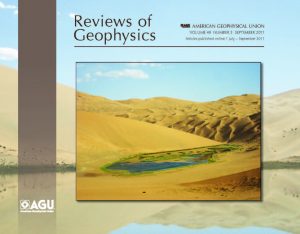
-
- Ravi, S., D. D. Breshears, T. E. Huxman and P. D’Odorico (2010), Land degradation in drylands: Interactions among hydrologic – aeolian processes and vegetation dynamics. Geomorphology, 116: 236-245. [Top 25 hottest articles in 2010 in Geomorphology]
- Field J. P., J. Belnap, D. D. Breshears, J. C. Neff, G. S. Okin, J. J. Whicker, T. H. Painter, S. Ravi, M. C. Reheis and R. R. Reynolds (2010), The ecology of dust. Frontiers in Ecology and Environment, 8: 423-430. [Featured in the cover /cover image]
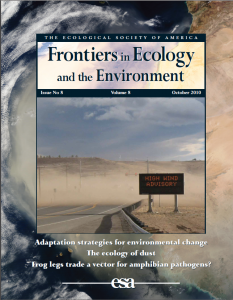
-
- Ravi, S. T. E. Huxman, S. L. Collins and P. D’Odorico (2010), Interactions between aeolian processes and fires: Implications for rangeland management. Rangeland Ecology and Management, (Invited synthesis), 63:267-274. [Featured in the cover/cover image]
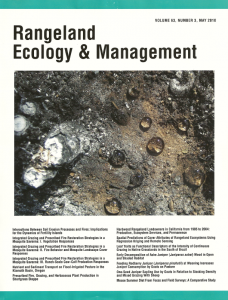
-
- Ravi, S., P. D’Odorico, L. Wang, C. White, G.S. Okin and S. L. Collins (2009), Post-fire resource redistribution in desert grasslands: A possible negative feedback on land degradation. Ecosystems, 12(3): 434 – 444. [Featured in the cover/cover image]
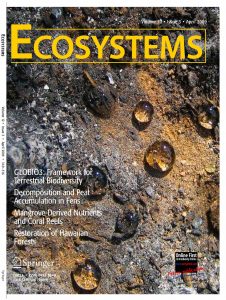
-
- Ravi, S., P. D’Odorico, S. L. Collins and T. E. Huxman (2009), Can biological invasions induce desertification? New Phytologist, 181(3): 508 – 511. [Recommended by F 1000, Faculty of 1000 in Biology]
- Ravi, S. and P. D’Odorico (2009), Post-fire resource redistribution and fertility island dynamics: A Modeling approach. Landscape Ecology, 24(3): 325 – 335.
- Ravi, S. and T. E. Huxman (2009), Land degradation in the Thar Desert. Frontiers in Ecology and Environment, 7(10): 517-518.
- Ravi, S., P. D’Odorico, T.M. Zobeck and T.M. Over (2009), The effect of fire-induced soil hydrophobicity on wind erosion in a semi-arid grassland: Experimental observations and theoretical framework. Geomorphology, 105 (1): 80 – 86.
- Ravi, S., P. D’Odorico, L. Wang and S. L. Collins (2008), Form and function of grass ring patterns in arid grasslands: the role of abiotic controls. Oecologia, 158: 545 – 555.
- Hui, J.W.C., B. I. Cook, S. Ravi, P. D’Odorico and J.D. Fuentes (2008), Dust-rainfall feedbacks in West African Sahel. Water Resources Research, 44: W05202.
- Ravi, S., P. D’Odorico, T. M. Zobeck, T. M. Over, and S. L. Collins (2007), Feedbacks between fires and wind erosion in heterogeneous arid lands. Journal of Geophysical Research – Biogeosciences, 112: G04007.
- Ravi, S., P. D’Odorico and G.S. Okin (2007), Hydrologic and aeolian controls on vegetation patterns in arid landscapes. Geophysical Research Letters, 34: L24S23.
- Ravi, S., P. D’Odorico, B. Herbert, T.M. Zobeck and T.M. Over (2006), Enhancement of wind erosion by fire-induced water repellency. Water Resources Research, 42: W11422. [AGU Editor’s Choice: Surface Processes]
- Ravi, S., T.M. Zobeck, T.M. Over, G. S. Okin and P. D’Odorico (2006), On the effect of wet bonding forces on the threshold friction velocity for wind erosion. Sedimentology, 53(3): 597- 609.
- Ravi, S., and P. D’Odorico (2005) A field-analysis of the dependence of wind erosion threshold velocity on air humidity. Geophysical Research Letters, 32: L21404.
- Ravi, S., P. D’Odorico, T.M. Over and T.M. Zobeck (2004), On the effect of air humidity on soil susceptibility to wind erosion: The case of air-dry soils. Geophysical Research Letters, 31: L09501. [AGU Editor’s Choice: Surface Processes]
Books
-
Macknick, J., H. Hartmann, G. Barron-Gafford, B. Beatty, R. Burton, C. S. Choi*, J.McCall, L. Nebert, S. Ravi, J. Schmidt, B. Staie and L. Walston (2022), The 5 Cs of Agrivoltaic Success Factors in the United States: Lessons From the InSPIRE Research Study, Technical Report NREL/TP-6A20-83566, National Renewable Energy Laboratory, Golden, CO.
-
Choi*. C, I. Z. Siregar, and S. Ravi (2020), Reframing the competition for land between food and energy production in Indonesia, in Land Cover and Land Use Change on Islands: Social & Ecological Threats to Sustainability, Walsh, S. J. et. al (Eds.), ISBN 978-3-030-43972-9, Springer.
- Ravi. S. and W. M. Cornelis (2019), Ecohydrological implications of aeolian processes in drylands, in Dryland Ecohydrology, 2nd Edition, ISBN 978-3-030-23268-92, Springer.
- D’Odorico, P and S. Ravi (2015), Land Degradation and Environmental Change, in Biological and Environmental Hazards, Risks, and Disasters, 1st Edition, ISBN: 9780123948472, Elsevier.
- Turnbull, L., S. Ravi, and J. Wainwright (2013), Vegetation Change in the Southwestern USA: Patterns and Processes, in Patterns of land degradation in drylands: understanding self organized geomorphic systems, Springer, DOI 10.1007/978-94-007-5727-1.
- Washington-Allen, R. and S. Ravi (2011), Dryland Analysis & Monitoring in Encyclopedia of Life Support Systems, UNESCO-EOLSS Publishers, Oxford, UK.
- Ravi, S., Highlights, Rangeland Ecology & Management, Rangelands, 32(3), 44-46
- Ravi, S., (2008), Feedbacks between Fires and Soil Erosion Processes at the Desert Margins, PhD Dissertation, University of Virginia, Charlottesville, USA. [Dissertation committee: Paolo D’Odorico, Hank Shugart, Greg Okin, Bob Swap and James Smith]
- Ravi, S., (2005), The Effect of Air Humidity on Soil Susceptibility to Wind Erosion, MS thesis, University of Virginia, Charlottesville, USA.
- National Research Council (NRC) Report (2008): A Frontier in Earth Surface Processes: Dynamic Interactions of Life and its Landscapes (contributing author from Meeting of Young Researchers in Earth Sciences MYRES 2008).
- Reinhardt L et al. (78 contributing authors) (2010), State of Science, Dynamics interactions of life and its landscapes: feedbacks at the interface of geomorphology and ecology. Earth Surface Processes and Landforms, 35:78-101.
-

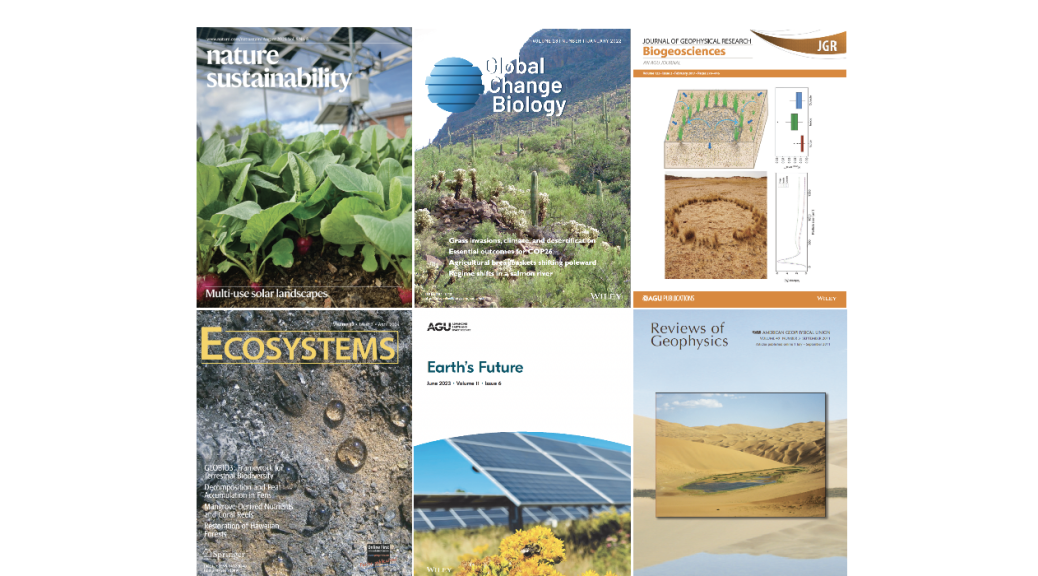
You must be logged in to post a comment.